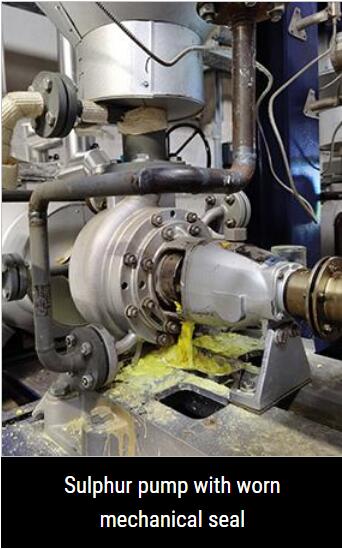Welcome to Sino Bearings web
24x7 HOTLINE:+86-28-81454188

 NEWS
NEWS
Rainer Landowski discusses the application of centrifugal pumps for liquid sulphur
Sulphur is a common element in nature and one of the most frequently used substances in petrochemistry and chemistry. The transport of sulphur often occurs in liquid form at temperatures above 125°C. Viscosity increases abruptly above 150°C. Good transport of liquid sulphur occurs in a temperature range between 125-145°C. This narrow range makes the selection of the pump – and especially of its shaft seal– challenging.
No seal is really tight. No matter how small the amount of leakage, escaping sulphur will crystallise in the ambient air and gum up the seal. Typically, a steam quench is then used to flush the leakage away from the seal. Ensuring the necessary steam temperature and volume to do this is challenging and not always successful.
Sulphur residues are always found in the vicinity of such pumps, and these must be removed at great expense. One solution is shaft sealing systems; but these are prone to failure and require a lot of maintenance.
What could be more obvious, therefore, than to replace the shaft seal with a magnetic coupling? Magnetic couplings operate leak-free and completely seal the pump chamber from the atmosphere. Sulphur cannot escape from the pump. The drive torque of the motor is transmitted to the pump rotor without contact by a strong magnetic field. In the air gap between the two magnetic coupling halves, a containment can statically seals the pump from the atmosphere.
Temperature Check
For the overall “sulpur pump” system to work, we need a heat balance for the pump to ensure that the minimum temperature of 125°C is safely reached. At the same time, the maximum sulphur temperature of 145°C must be prevented from being exceeded by the internal losses of hydraulics and magnetic coupling.
The pump body is designed with heating chambers. The heating chambers are heated with steam at a temperature of approximately 135°C. The heating chambers are generously dimensioned to achieve the fastest possible heating of the entire pump body. Reaching the working temperature is verified by means of PT-100 in the area of the pump’s sliding bearing.
Special attention must be paid to the containment can. The rotating magnetic field induces eddy currents in a metallic containment can, which are normally considered a loss.
However, when pumping liquid sulphur, they help to heat the sulphur even in this narrow gap and keep it pumpable. A heating chamber charged with steam in close proximity to the magnetic gap ensures that the eddy currents do not cause the liquid sulphur to overheat and thus increase in viscosity. With a little experience, the sizing of the various temperature control sources is easy to perform.
With the help of a temperature measurement inside the magnetic gap, this function can be controlled very easily and accurately.
Magnetic drive pumps are now established in many industrial sectors and have pushed back complex mechanical seal systems. In the chemical industry, magnetic drive pumps account for more than 30% of new investments.
In many cases, sulphur pumps are operated in countries that are still at the beginning of their industrial development. Plant cleanliness and reliability may not have the priority there that is expected in Europe.
However, globalisation is leading to world-class production standards even in less developed countries. Magnetic drive pumps help to achieve this more quickly and are no longer complicated at all once their function has been understood.